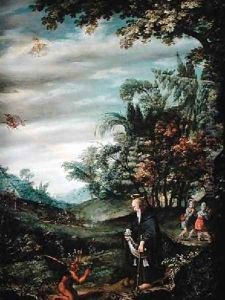Kerstiaen de Koninck Paintings
Kerstiaen de Keuninck, also known as Kerstiaen de Koninck, was a Flemish painter born in Courtrai (present-day Kortrijk, Belgium) in 1601. He is not to be confused with the more famous Dutch painter Gerrit Dou's pupil, Gérard de Lairesse, who was sometimes known by the same name. De Keuninck's work is typical of the Flemish Baroque period, and he is best known for his landscapes and scenes of ruins, which were influenced by the earlier Mannerist style.
De Keuninck was apprenticed to the landscape painter Abraham Govaerts in Antwerp. Govaerts was known for his small-scale forest landscapes and worked in a style similar to Jan Brueghel the Elder. Under Govaerts' tutelage, de Keuninck developed a meticulous approach to his work, often focusing on the effects of light and atmosphere in his depictions of natural and rural scenes.
Moving beyond his master's influence, de Keuninck began to incorporate more dramatic perspectives and a stronger sense of vastness in his compositions. His landscapes often featured mountainous terrains, with figures and animals included to provide scale and narrative. He also had an affinity for depicting fire, with several works capturing the dynamic and destructive beauty of blazes in rural settings. His use of color and light was notable, with an emphasis on dramatic skies and the interplay between light and shadow.
While de Keuninck enjoyed some success in his lifetime, his works were often overshadowed by those of his contemporaries in the highly competitive Flemish art scene. He did not establish a significant school of followers, which, coupled with a relatively small body of work, contributed to his lesser-known status in the annals of art history.
Kerstiaen de Keuninck passed away in 1651 in Antwerp. Today, his paintings can be found in various museums and collections across Europe, offering insight into the Flemish interpretation of the Baroque landscape genre. Although not as widely recognized as some of his contemporaries, de Keuninck's contributions to landscape painting continue to be appreciated for their detail, composition, and atmospheric qualities.
